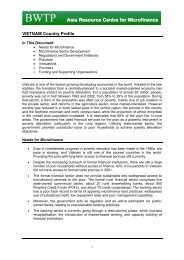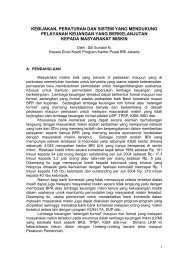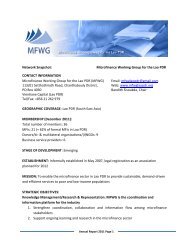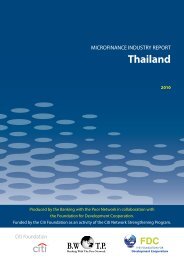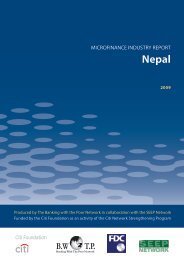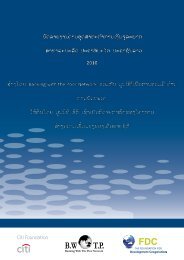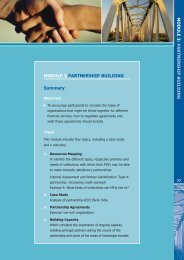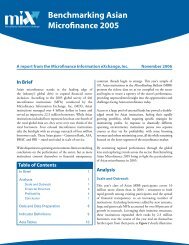Nguyen Hong Hanh - Banking with the Poor Network
Nguyen Hong Hanh - Banking with the Poor Network
Nguyen Hong Hanh - Banking with the Poor Network
You also want an ePaper? Increase the reach of your titles
YUMPU automatically turns print PDFs into web optimized ePapers that Google loves.
Innovation in Save <strong>the</strong>Children/US MicrofinanceProgram in VietnamMicrofinance Regional WorkshopSharing microfinance resources andknowledge in <strong>the</strong> Mekong regionPhnom Penh, Cambodia, Dec 2004
Overview Background History of Save/US microfinance in Vietnam Strengths & weaknesses of partner organization New partnership modality pilot in peri-urban area2
Background Since 1986, Vietnamese Gov’t has pursued anational strategy to fight hunger and poverty; Since 1989, a series of reforms has been carriedout in agriculture & finance, resulting in rapiddevelopment of rural financial sector; Poverty rate was 29% in 2002, compared <strong>with</strong>37% in 1998 & 57% in 1993;Rural financial sector has 3 sub-sectors: Formalsector, semi-formal sector, and informal sector3
History of Save/US microfinanceprogram Launched a rural program in 1998 in a poor district inThanh Hoa province & had 550 active clients; Expanded to additional 3 districts in <strong>the</strong> same provinceas of 2004; Rural program has 9,500 active clients as of Nov. 2004; Launched an urban program in late 2003 in outskirts ofHanoi; Urban program has 1,300 active clients as of Nov 20044
Save/US goal in microfinance Save/US’ goal in micro-finance is to buildsustainable institutions that provide on-goingaccess to financial services for poor womenmicro-entrepreneurs. Where credible local partners exist, Save/USworks <strong>with</strong> <strong>the</strong>m to build <strong>the</strong>ir capacity bothtechnically and institutionally.5
Partner Organization – Women’sUnion (WU)AdvantagesExtensive network;No need to recruit new staff;Existing organizationalstructure is used to deliverprogram;WU cadres are familiar <strong>with</strong>locality & economic situationof members;Program can beimplemented & outreachachieved fairly quickly;DisadvantagesWU lacks <strong>the</strong> businessmanagement skills to run asustainable program;WU’s social and politicalorientation may not becompatible <strong>with</strong> objective offinancial sustainability;Priority may be placed more on# of clients ra<strong>the</strong>r than onquality of loan;Existing structure may not beappropriate and can hinder <strong>the</strong>productivity of <strong>the</strong> program6
Considerations for Urban Program In <strong>the</strong> region, more commercial banks are entering <strong>the</strong> marketto increase market coverage and profits; MF’s becoming more business-like and cost-efficient due tohigher competition and fewer donor resources; MF needs commercial funds to achieve scale and financialsustainability; Save/US needs an program arrangement that will facilitate itstransformation into an MFI once <strong>the</strong> legal framework is inplaceChoose a new partner: COMMERCIAL BANK7
Banks and MFI’s meet$BANKsFinancial PurposeBusiness ApproachMFIsSocial MissionBusiness ApproachNGOsSocial MissionCommunity Approach8
Service Delivery PartnershipService CompanyConsulting providingsupport to <strong>the</strong> bankThe <strong>Poor</strong>is ServedLocal PrivateCommercial BankPerforming lending entrustmentSave <strong>the</strong> Children/US–NGOTechnical Assistance &Institutional Support9
Save/US roles Introduce international best practices in microfinance; Provide institutional capacity building for <strong>the</strong> Company Provide loan funds through <strong>the</strong> Bank; Compensate <strong>the</strong> Bank for its services Pay consulting fee & infrastructure setup for <strong>the</strong>Company; Subsidize <strong>the</strong> Company before break-even; Explore <strong>with</strong> <strong>the</strong> Bank & <strong>the</strong> Company <strong>the</strong> possibility toobtain soft loans from big donors; Build State Bank’s support over microfinance sector10
Commercial Bank roles Provide a legal lending license; Provide loan funds needed for <strong>the</strong> servicecompany operation; Review activity & financial reports of <strong>the</strong>CompanyMaintain least involvement !!!11
Service Company roles Launch promotion of loan products; Coordinate <strong>with</strong> relevant local authorities & massorganizations; Conduct borrower assessment & training; Arrange loan contracts; Facilitate disbursement and collection of loans; Perform book keeping; and Prepare activity & financial reports12
Analysis: Pros No need for a banking license; The company holds <strong>the</strong> technology and<strong>the</strong>refore can spin off when possible; The company is not a financial entity and doesnot require a large equity base; The company has its own structure, governance,staffing, that can be similar to an MFI; The company can develop more appropriatecorporate culture for <strong>the</strong> poor; Potential access to plentiful and low-cost funds13
Analysis: Cons Microfinance is new to a majority of commercial banks; It can be difficult to find a commercial bank that is willingto get involved in micro-finance in <strong>the</strong> way we want; The entrustment and consulting fees may be high anddifficult to calculate; Products are limited to loans only; Bank might be reluctant to record high volume oftransactions; Save/US might not familiar <strong>with</strong> building support for acompany and partnering <strong>with</strong> a commercial bank14
Institutional arrangement so far… Service Company was registered as a LLC and functionsas an independent entity; Company charter was developed <strong>with</strong> a social missionand a commitment to operate to international standards; Company Board represents a combination of people <strong>with</strong>complementary strengths; Save US seconded an employee to act as ManagingDirector; Negotiation <strong>with</strong> a commercial bank is in final stage; Program operations are still underway under atemporary memorandum of understanding <strong>with</strong> <strong>the</strong> localWU;15
Program operations so far… Service Company has 2 branches and 1regional office; 1,300 active clients after one year of operation; Repayment rate 100%; 35% of operating costs is covered <strong>with</strong> interestincome; 123 active clients/loan officer – 40% of target Trainings in lending methodology, book-keeping,product development, market surveys, &financial ratios were offered to Company staff16
Future development Transform <strong>the</strong> Company into an MFI when <strong>the</strong>Microfinance Decree is passed; Save/US will becomes an investor in <strong>the</strong> MFI; Invite <strong>the</strong> Commercial Bank to be an investor ora wholesale-loan provider for <strong>the</strong> MFI;17
Lessons Learned Service company model can be an excellent approach incountries where <strong>the</strong>re is no legal framework; Careful selection of traditional commercial bank; Careful selection of <strong>the</strong> board/leadership for <strong>the</strong>company; Roles and responsibilities of parties need to be clearlydefined; Partnership can be significantly modified to meetprogram objectives as well as overcome contextconstraints;18
Lessons Learned (continued) Agreement issues may be complicated andnegotiation is time-consuming; HO and local lawyers should communicatedirectly; There is no perfect option and be ready toaccept some risks; It may take much more time than planned soplease be realistic in your planning19



